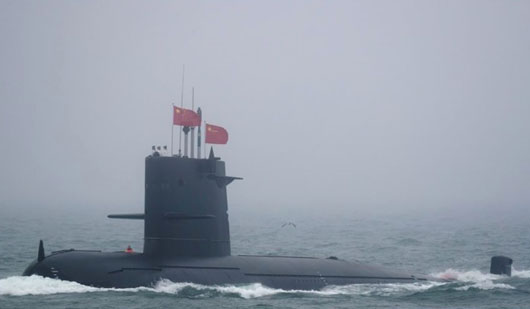Special to WorldTribune.com
The rising tide of China’s military modernization, expansion, and force projection capabilities has long haunted policymakers from the United States to East Asia.
But while many Washington politicians were premised on the paradigm of China’s “peaceful rise” and a world of global commerce with only occasional political friction, the stark reality is emerging that the People’s Republic has been building an increasingly formidable and sophisticated military machine with global ambitions.

It is precisely the massive trade deficits favoring China, which provide Beijing with the financial means and technological capacity to pursue its geopolitical goals.
The annual Pentagon report on China’s Military underscores and elaborates the challenge.
As in past assessments the survey shows the expanding size and scope of the Beijing regime’s military capacities. Most alarming, the expansion and sophistication of China’s nuclear forces, its ground-based missiles, and cyber war capacity. The Chinese Navy is now larger than the U.S. Navy.
Yet the old quantitive versus qualitative advantage argument goes only so far; I recall many NATO briefings in Belgium and Germany now a generation ago, where the Soviets decisively outnumbered us in tanks, artillery and aircraft. The U.S., West German and British advantage rested in better quality equipment, more formidable air assets, and holding a defensive position.
Contemporary East Asian states, notably Japan, South Korea, Taiwan and let’s include Australia would be in a defensive position facing PRC probes, posturing and forays. But there’s a significant difference.
Contrary to communist China’s bellicose revolutionary rhetoric during the 1960’s in which blustering Chairman Mao’s massive but underprepared military even threatened the Soviets, modern China now has the economic clout and sophisticated weapons systems to back it up. Beijing’s military modernization increasingly focuses on qualitative systems, a smaller and more effective force, and lethal cyber warfare capacities.
Related: Pentagon: PLA prioritizing non-war and information ops, continues sub buildup, Sept. 8, 2020
The strong economic component largely eluded the former Soviet Union.
The so-called People’s Liberation Army/Navy (PLAN) while now numerically larger than the U.S. Navy, “with an overall battle force of approximately 350 ships and submarines including over 130 major surface combatants. In comparison, the U.S. Navy’s battle force is approximately 293 ships as of early 2020.”
Even if we allow for advanced U.S. Navy technology and coordinated battle force operations, the Chinese Navy would be largely focused in theater and not half a world away from its home bases. Moreover, the 293 ship U.S. Navy is already stretched too thinly covering global responsibilities and commitments from the Persian Gulf and Mediterranean; China again would be overwhelmingly focused on home waters in East Asia and the disputed South China Sea.
Carrier technology is hard to master and coordinate; you don’t buy a carrier off the shelf, read the directions, and suddenly deploy a battle group. This takes years of training, practice and coordination for which the U.S. Navy excels. However, Beijing’s two carriers and escort ships would be by geography operating close to the People’s Republic, not half a world away as would be American ships.
Trade deficits fueled Beijing’s military black box programs; joint ventures with some American firms allowed China foreign technology acquisition.
Beijing’s Belt and Road project throughout the developing world has offered recipient countries infrastructural development and favorable loans but equally has teams of Chinese engineers scouting out and perhaps pre-positioning supplies in states across a wide swath of South Asia and into East Africa.
The report suggests, “A global PLA military logistics network could interfere with U.S. military operations and provide flexibility to support offensive operations against the United States.”
Made in China Beijing’s focused industrial plan is set to bypass the USA as the world’s largest economy by 2025, replacing China’s traditional lower end exports with higher quality technology such as semiconductors and pharmaceuticals.
Since President Xi Jinping assumed power at the 18th Party Congress in 2012, the CCP Central Committee has placed greater emphasis on China’s foreign policy advancing “the cause of Socialism with Chinese Characteristics.” Chairman Xi’s high-octane nationalism combined with communist discipline poses a dangerous combination.
Dr. Andrew Erickson of the Naval War College asserts, “Two decades ago, many would have dismissed the notion that China’s armed forces could achieve parity with, let alone exceed, the American gold standard in any form save sheer numbers of personnel.” He adds, “Under the CCP, China clearly aims for increasing parity with the United States, as measured in overall military capabilities, influence, and recognition.”
Presenting a starkly realistic survey, the Pentagon’s account is hardly harem-scarem hyperbole but focuses on a formidable and looming adversary.
John J. Metzler is a United Nations correspondent covering diplomatic and defense issues. He is the author of Divided Dynamism the Diplomacy of Separated Nations: Germany, Korea, China (2014). [See pre-2011 Archives]

 By
By